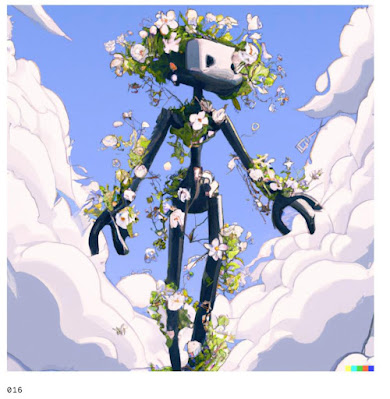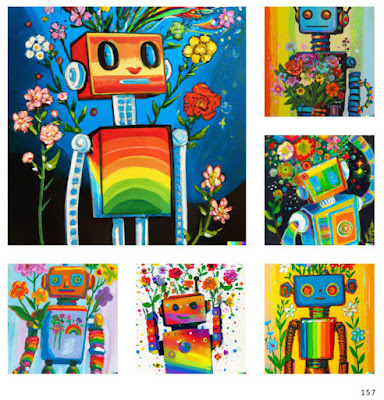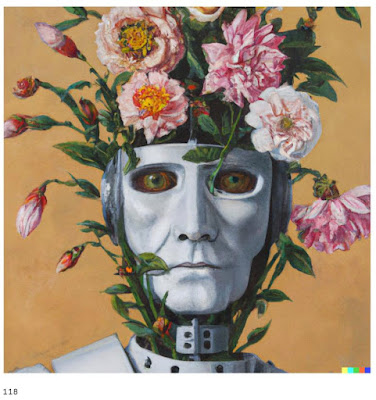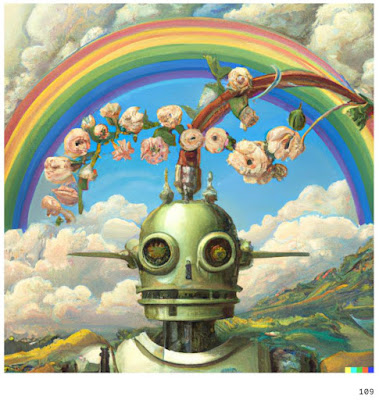How would you imagine a painting of a robot with flowers growing out of it?
"A happy robot with flowers growing out of his head, clouds in the background, digital art."
It's a whimsical idea that might make a fun concept for a children's book.
"A detailed painting of a rainbow colored robot with flowers growing out of its head."
Or it might be a promising pitch for an animated film."A Rene Magritte painting of a robot head with flowers growing out of the top with clouds in the background."
It could also be a theme for a group exhibition of surrealistic gallery art.
"A painting by Syd Mead of a bipedal robot with flowers growing out of the top of its head."
Designer Ben Barry used variations on this idea to generate over a thousand images in different styles. Mr. Barry is not an imagemaker in the usual sense. He is one of the lucky few who received beta access to the AI computer tool called Dall•E 2.
"A woodblock print of a bipedal robot with flowers growing out of the top of its head."
Mr. Barry came up with the instigating phrases or prompts, and Dall•E 2 did the rest, creating hundreds or even thousands of novel images in a few hours. The prompts sometimes used the names of dead artists to catalyze the results, but more often than not the prompts were just descriptive.
These are all high resolution images, adequate for magazine reproduction.
"A painting by Caravaggio of a robot head with flowers growing out of the top."
Mr. Barry edited a digital book that you can check out for free called 1000 Robots on Archive.org. He chose the subject matter of flowers and robots because "I find the idea of an artificial intelligence painting robots to be simultaneously humorous and endearing."
"A painting by Norman Rockwell of a robot head with flowers growing out of the top with clouds
and a rainbow in a background, digital art"
The technology seems adept at understanding the artistic logic of the prompt, both in terms of style and content. But there are a few incongruous elements, such as the weird red cable that arcs over to the rainbow.
Mr. Barry says: "While the model is capable of generating other types of images, I found paintings to be the area where it truly excelled aesthetically."
"A colorful painting by M.C. Escher
of
robot
head with flowers growing out of the top"
The survey of styles resembles a Society of Illustrators exhibition or a professional illustrators' workbook. The foregoing two pages don't strike me as particularly reminiscent of Rockwell or Escher, but to me they score quite high on internal coherence and aesthetic appeal.
Right now only a few people have access to this tool, but presumably it will soon be widely available essentially for free.
"a dramatically lit brightly colored detailed painting of a robot artist painting a picture"
The power of this artificial intelligence gives me a mixture of feelings: I'm surprised, delighted, intimidated, and a bit breathless at the speed of the progress.
If you are an illustrator or gallery artist who paints surrealistic images in your particular style, it's a good time for soul-searching.
You might consider:
1. How you would use these tools.
2, How you will provide value for clients who have these tools.
3. How you will create artwork that these tools can't accomplish.
This system of artificial intelligence won't eliminate traditional human artists—(and by "traditional" I include digital artists with those who use physical paint.)
But it will send shock waves through the illustration world, and it will replace a lot of jobs. Soon, anyone and everyone will be able to create images easily, cheaply, and quickly with simple prompts of natural language.

















18 comments:
James,
I want to see how Dall•E 2 will deal with subjects I like the most: Animal drawing and painting.
It's a wonderful and terrifying new world.
Paulo-Rio
This leaves me with mixed feelings of eagerness, dread, curiosity, anxiety, and awe. The future of art feels exciting and scary.
These are very impressive examples of Artificial Intelligence art. Still, the medium is pixels. I would be really impressed if an AI robot actually used real world materials, applying paint with brushes. Maybe if an art robot studied some James Gurney videos they could learn how it is done! ;-)
I agree, Paulo.
Here are some prompts that I bet Dall•E2 would have a very hard time with:
1. An old boyfriend arrives to disrupt a rural wedding, 19th century Salon.
2. How I eat a rapidly melting ice cream cone, 4 panels animation storyboard.
3. Busy cook with pots boiling over hears a policeman at the door, 1940s style.
4. A released prisoner of war meets his kids again after three years.
That's hilarious, Master! :)))))
I will try this:
"A mailman runs away from a pack of Chihuahuas, James Gurney style painting."
I doubt that they will release this software someday:
It would be a revolution.
Can't say that I follow your logic. "It won't eliminate traditional artists, but it will send shock waves through the illustration market" Anyone wanting to paint traditionally if they wish is the ONLY thing that won't change. Selling that work, whether it be fine art painting, or illustration definately will change. I don't understand why you thing that the examples of work it may not be able to do now, won't be childs play in the future. Tech has done this to so many jobs. Why would anyone pay for a painting to hang on their wall when they could do it themself? It will not matter that they have no concept of design, drawing ability, color harmony, composition, values,etc., but they will all proclaim "I made it myself!"
To me this seems like the moment of total image saturation. Possibly similar to the photograph moment in the way that it staggers one holding a paint brush or pencil. I think shockwaves is the right expectation. Market is affected certainly, but Audience too because image saturation reduces attention to zero.
And it's not only abstract, imaginative images. See the "astronaut riding a horse in photorealistic style", or variation on the girl with pearl earrings. (site: https://openai.com/dall-e-2/)
And it's not only images but language processing. So imagine receiving several hundred thousand beautifully illustrated children's books using one of those prompts. Imagine that hitting a blog, or an inbox, or mailed to you, or filling all of the shelves at walmart.
The openai language examples are here: https://beta.openai.com/examples/
These have a technical bent, but I am guessing that's not an actual limitation. Don't you get the idea that the developers of the tool are keeping some of the real implications, use cases hidden for fear of terrifying the public? The training data could anything within the scope of art.
My mind (feelings) go quickly to this thing humiliates human creativity in exactly the way that the chess engines humiliate human players.
I know that recently human chess players began to use the engines as tools for training, and so made huge leaps in ability not previously possible using traditional methods. Possibly it's reasonable to expect similar uses of this image generation- to dramatically grow and change what's possible with human ability. And further, this thing doesn't impede or diminish my experience of the natural world, the saltiness of the air, say. But let's say I want to report on my experiences and feelings using art (esp. visual), who will be the audience?
Wow, these were all done with AI? That's terrifying.
Sheridan, reasonable questions. The reason I think those prompts will be out of reach for a long while is that the tech doesn't seem to do well with semantic, psychological, or human-experience-centric ideas. Read Gary Marcus's argument about why machine-learning based AI will always have these limits. When I say the tech won't eliminate hand-made art, I mean that there will still be a place for us, but our role may shift in unexpected ways, as it did after the invention of photography. The way I'd answer you last question is that gallery art, as long as it can define itself as a rare collectible commodity, will always have a place regardless of these innovations. But I don't doubt that the first pillar to fall is style-driven concept illustration.
Much as I'm impressed with the technical innovation here I am quite glad that whilst I do digital art I am predominantly producing physical paintings.
One thing I have wondered about is if it would impact the NFT art world. Whilst I've never sold an NFT because it strikes me too much as "Emperor's new clothes" I have looked into it.
As far as I can tell there is more apparent value in having a human-created artwork that is truly unique as a vehicle. I have been told that if I listed the same digital drawing then I can re-list it with a slight change, such as a different colour scheme then it will still be just as worthwhile as long as it's unique.
I don't know how true that is, but above we have a program able to produce radically different designs, mostly indistinguishable from human creations and to my eyes at least - more attractive than a lot of art listed on NFT marketplaces.
It shouldn't take too much of an imagination stretch for the next step to be to generate a million different but high quality artworks specifically for sale as NFT's and surely devaluing that whole marketplace?
My brain hurts now, I'm going back to my brushes, I've got some skills to develop...
Unknown, those are all good points. When you say, "Don't you get the idea that the developers of the tool are keeping some of the real implications, use cases hidden," it reminds me that OpenAI has allowed only a very small set of trusted users to beta test the system, and they have asked them not to share images that use photoreal faces, especially not of real people. The other main use potential of this tech is to add anything or anyone into any image and match the lighting and style. Potential for abuse is huge.
Thanks for engaging us on this James. I've gone adrift. Here are some additional notes and reflections.
Image creation (in the metaverse) is now Instant, Unlimited, Targeted (individualized), Profound, Beautiful.
We already knew that AI will compete for and win human attention, and instantaneous gratification has long been a feature of the digital world. So I think a major aspect of the shock for me is that the image creation is now Profound, Beautiful.
Profound, Beautiful: because the AI is a mirror, a kind of generative reflection, it reflects the profundity and beauty embodied in the training data (the set of all human-created images potentially). The generative art is as good as the art in the training model and prompt, so see the poor pencil drawings (“pencil drawings” includes a lot), conversely see “in the style of davinci.” or "in the style of _______"
As an example, see results for the prompt: "Astral Codex 10" (site: https://www.lesswrong.com/posts/r99tazGiLgzqFX7ka/playing-with-dall-e-2)
Are these profound and beautiful? Yes, definitely. There is a whole history of human visual creation in these. Beauty is an input; Beauty is an output.
Another one that has really capture my attention is Samurai Thinker: https://twitter.com/hardmaru/status/1519312170202595328/photo/2
"One way you can think about this neural network is transcendent beauty as a service,” says Ilya Sutskever, cofounder and chief scientist at OpenAI.
(Source: https://www.technologyreview.com/2022/04/06/1049061/dalle-openai-gpt3-ai-agi-multimodal-image-generation/)
Yes, we have arrived at a point in time where the brochure now reads "Transcendent beauty as a service."
It's Theft. Take as a solitary example " in the style of M.C. Esher." And now you are tossing around hundreds of images for someone to like and to barely glance at. But what about Esher, his life, his work. It’s now just a smallish training module for dalle2 and he isn’t necessary. Except in that his images trained her.
(Maybe one thing that artists with pencils and paint will do in the future is continue to train generative mirrors on new expressions of beauty, only this time with cognizance.)
Theft, but also Desecration. "Spongebob as an Eastern Orthodox Icon." Remember Charlie Hebdo?
~~~~
As far as what entire industries dalle2 disintegrates, I think you can see some indication listed in this document: https://github.com/openai/dalle-2-preview/blob/main/system-card.md
To wit, "...could displace jobs of designers, photographers, models, editors, and artists."
Consider that to sell beer you used to have to hire some beautiful people and fly then to somewhere beachy, and hire some other people to stage the cabana, and still other people to put together the final layouts or whatever.
Now you have "transcendent beauty as a service."
Designers in general are affected, because it's now trivial to generate variations on designs to "innovate." Consider what the design process used to be to create a "really cool looking car", or "watch on the wrist of a man who has it all," or "stunningly glamorous dress," or "facade for the office of an affordable safe family dentist"
~~~
On safety, this preview limitations document from openai addresses other concerns, but to me the safeguards are inadequate.
Relatedly, see https://thispersondoesnotexist.com/ for some GAN people, and links to libraries to train your own.
The gauntlet was thrown ages ago, imo, when digital art became popular. This isn't about "artist vs machine" because a machine can only do what it is programmed to do. Instead, think of it as "artist vs software designer". Software designers communicate by writing code, not through emotional experience. Code can create pictures. But do you want to make pictures, or do you want to create art?
Can any AI create an artwork based on the emotional human experience we feel? Can they create something that instantly communicates a shared experience with the viewer? I think not. That is the challenge artists now face, have always faced. Code writers start with "how can I create a computer program that will copy this human behavior"? Artists start with "how can I communicate this experience to another person"? These are two different motives requiring vastly different skills. To be good at one doesn't mean you'll be good at the other.
Now is the time for human artists to use their inherent imagination and creativity to our advantage!
This is a great article! It's really informative and provides valuable insights. Thanks for sharing!
Cheap flower delivery Kuwait
I can see that you have done your research and put a lot of thought into your argument. Your evidence-based approach is impressive
mothers day gifts pakistan
Robots with flowers art is a unique and eye-catching art style that combines robotic elements with beautiful floral designs art. This art style can be used to create a variety of artwork, from paintings to sculptures to digital art. You can get style art from Val Master Fine Art. They are very proffesional.
The idea is really real and unique. The way you have portrayed the flowers in between the robots and manifested them, I must say that you have already preconceived the future. Day by day artificial intelligence is expanding. Maybe a day will come when these paintings come as a matter of fact. The paintings are beautiful and realistic too. I wish through this message people will get an idea and will be more careful.
ai an amazing techonology https://apknety.com/
Post a Comment